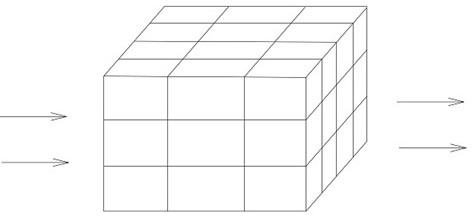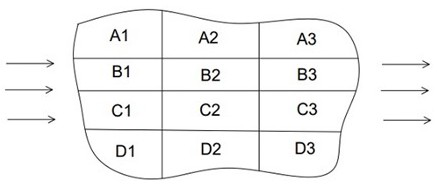A method and system for detecting clogging and short flow in subsurface constructed wetland
A technology of artificial wetlands and detection methods, applied in chemical instruments and methods, heat measurement, measurement devices, etc., can solve problems such as obstacles, inability to evaluate clogging degree levels in real time, conductivity and background value interference detection results, etc., and achieve a simple structure. Effect
- Summary
- Abstract
- Description
- Claims
- Application Information
AI Technical Summary
Problems solved by technology
Method used
Image
Examples
Embodiment 1
[0030] A method for detecting blockage and short flow in subsurface constructed wetlands, the specific detection steps are as follows:
[0031] Set the detection points, and arrange the upper and lower layered points in the selected constructed wetland area, such as figure 1 As shown, the 3D model of the wetland must first be obtained, that is, the length, width and height of the wetland as a whole. The 3D model has the same proportion as the wetland. The 3D model can be obtained from the existing database. Corresponding data information will be stored in the database of the unit, and the selected constructed wetland area can also be measured to obtain approximate 3D model data parameters, such as figure 1 As shown, according to the height of the 3D model, it is divided into 3 layers. Each layer adopts the same grid for point distribution. Each grid point represents a detection point. The area of each grid point is based on the overall area of each layer. For division, th...
Embodiment 2
[0038] A method for detecting blockage and short flow in subsurface constructed wetlands, the specific detection steps are as follows:
[0039] Set the detection points, and arrange the upper and lower layered points in the selected constructed wetland area, such as figure 1 As shown, the 3D model of the wetland must first be obtained, that is, the length, width and height of the wetland as a whole. The 3D model has the same proportion as the wetland. The 3D model can be obtained from the existing database. Corresponding data information will be stored in the database of the unit, and the selected constructed wetland area can also be measured to obtain approximate 3D model data parameters, such as figure 2 As shown, each layer has a total of 12 grids, which are divided into four areas A, B, C and D by row. Each grid point is a detection point. Each detection point in the 3D model is consistent with the actual wetland One-to-one correspondence of areas, according to the area ...
Embodiment 3
[0066] A subsurface constructed wetland blockage and short flow detection system, including a wetland detection distribution unit, a plurality of temperature sensors, a data conversion unit, a data transmission unit, a receiving analysis module and a variable temperature water flow control device;
[0067] The wetland detection and distribution unit includes a wetland model acquisition module, a regional stratification module and a single layer distribution module, the wetland model acquisition module is used to obtain a three-dimensional model of the wetland, and the regional stratification module is used to carry out the three-dimensional model of the wetland The upper and lower layers, the single-layer distribution module includes a single-layer distribution area calculation module and a single-layer distribution quantity division module, the single-layer distribution area calculation module calculates the total area of each layer, and calculates the single distribution are...
PUM
 Login to View More
Login to View More Abstract
Description
Claims
Application Information
 Login to View More
Login to View More - R&D
- Intellectual Property
- Life Sciences
- Materials
- Tech Scout
- Unparalleled Data Quality
- Higher Quality Content
- 60% Fewer Hallucinations
Browse by: Latest US Patents, China's latest patents, Technical Efficacy Thesaurus, Application Domain, Technology Topic, Popular Technical Reports.
© 2025 PatSnap. All rights reserved.Legal|Privacy policy|Modern Slavery Act Transparency Statement|Sitemap|About US| Contact US: help@patsnap.com



